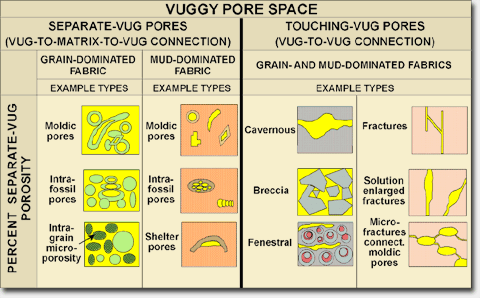
Estimating Permeability in Carbonates Using the Rock-Fabric Method
F. Jerry Lucia
Bureau of Economic Geology
| Design Objectives |
| Glossary |
| Credits |
| Back |
| Top |
| Exit |
 |
 |
| Rock-Fabric
Classification
Classification of Vuggy Pore Space The addition of vuggy pore space to interparticle pore space alters the petrophysical characteristics by altering the manner in which the pore space is connected, all pore space being connected in some fashion. Separate vugs are defined as pore space that is interconnected only through the interparticle porosity. Touching vugs are defined as pore space that forms an interconnected pore system independent of the interparticle porosity (Fig. 6).
Separate-Vug Pore Space Separate-vug pore space is defined as pore space that is 1) either within particles or is significantly larger than the particle size (generally >2 x particle size), and 2) is interconnected only through the interparticle porosity (Fig. 6). Separate vugs are typically fabric-selective in their origin. Intrafossil pore space, such as the living chambers of a gastropod shell; moldic pore space, such as dissolved grains (oomolds) or dolomite crystals (dolomolds); and intragrain microporosity are examples of intraparticle, fabric-selective separate vugs. Molds of evaporite crystals and fossil molds found in mud-dominate fabrics are examples of fabric-selective separate vugs that are significantly larger than the particle size. In mud-dominated fabrics, shelter pore space is typically much larger than the particle size and is classified as separate-vug porosity whereas in grain-dominated fabrics, shelter pore space is related to particle size and is considered intergrain porosity. In grain-dominated fabrics, extensive selective dissolution of grains may cause grain boundaries to dissolve, producing composite molds. These composite molds may have the petrophysical characteristics of separate vugs. However, if dissolution of the grain boundaries is extensive, the pore space may be interconnected well enough to be classified as solution-enlarged interparticle or touching-vug porosity. Grain-dominated fabrics may contain grains with intragrain microporosity (Pittman 1971). Even though the pore size is small, intragrain microporosity is classified as a type of separate vug because it is located within the particles of the rock. Mud-dominated fabrics may also contain grains with microporosity, but they present no unique petrophysical condition because of the similar pore sizes between the microporosity in the mud matrix and in the grains. Touching-Vug Pore Space Touching-vug pore systems are defined as pore space that is (1) significantly larger than the particle size and (2) forms an interconnected pore system of significant extent (Fig. 6). Touching vugs are typically nonfabric selective in origin. Cavernous, breccia, fracture, and solution-enlarged fracture pore types commonly form an interconnected pore system on a reservoir scale and are typical touching-vug pore types. Fenestral pore space is commonly connected on a reservoir scale and is grouped with touching vugs because the pores are normally much larger than the grain size (Major et al. 1990). Fracture porosity
is included as a touching-vug pore type because fracture porosity
is an important contributor to permeability in many carbonate reservoirs
and, therefore, must be included in any petrophysical classification
of pore space. Although fracturing is often considered to be of
tectonic origin and thus not a part of carbonate geology, diagenetic
processes common to carbonate reservoirs, such as karsting (Kerans
1989), can produce extensive fracture porosity. The focus of this
classification is on petrophysical properties rather than genesis,
and must include fracture porosity as a pore type irrespective of
its origin. |
